Site index
About
Dance calendar
Dance courses
Noticeboard
Dance reports
Techiques
Improvisation
Schottishe
Hambo
Waltz
Snoa & Polka
Mazurka
Polskor
Modern Dance
Other
Links
..Courses
..Festivals
..Other
History
Blog
Outdoors
..Reports
..Walk Guide
..Mountain walks
Dogs
..Lava
Preferences
Login
Contact
Polskor
- Contents: Variation of some popular Swedish Polska Dances
- Description
Bingsjöpolska, Slängpolska från Sörmland, Bodapolska, Orsapolska and Rättvikspolska
Target Audience: Experienced dancers - Author: Örjan Wikström
- Genre: Dance (Swedish polskor)
Contents
- Ingress
- Polska from Bingsjö - Bingsjöpolska
- Slängpolska from Sörmland
- Polska from Boda - Bodapolska
- Polska from Orsa - Orsapolska
- Polska from Rättvik - Rättvikspolska
- Bondpolska
Ingress
Polskor, like other traditional dances, have likely been danced using different styles and steps over time. While each type of polska has it's own characteristics, as always in social dancing there is a range of variation of how different dancers have adopted the dances.
For this reason the most accurate way of naming polskor is probably to use the place where it comes from as an attribute - Polska from ...
The descriptions below is our own contribution to this variation, and explains how we prefer to dance and vary some polskor.
We neither can nor want to claim that these descriptions explain how the dances traditionally have been danced.
Polska from Bingsjö - Bingsjöpolska
The Bingsjö polska melodies are mostly smooth. For this reason we prefer to aim for a floating feeling in the dance, using as insensible steps as possible.
When I was a beginner and joining a course in gammaldans, I was told that in Bingsjöpolska a low, steady carriage similar to a gorilla was preferable, using bended knees, with both feet staying on the floor as long as possible, keeping an exceedingly good balance
According to my own experience, it is difficult to achieve this without already having started the turn at the first beat in the bar, and turning on the right foot on the third beat.
I prefer to have my left arm over the right arm of the lady and stay on a small distance from the lady, in a position that allows a smooth, imperceptible transition between ordinary Bingsjö-polska and the enben (one leg) polska.
In the springpolska (repose variant) I prefer to dance with my steps to the left of the lady, using a substantial forwards movement. The reason to this is that I want to keep the same transportation speed as those dancing polska or enben around me.
Slängpolska from Sörmland
I came in touch with this polska in my early dancing days, although later than the Bingsjöpolska. At that time it was emphasised that this polska - similar to the Bingsjö polska - has smooth melodies, and that the dance preferably should reflect this.
This polska is danced in stain. The couple stay in a small sub area of the dance floor for the entire dance. The first (and sometimes only) part of the polska is danced with walking steps, one step per beat in the music, and mostly with a crossed double hand hold. The couple mainly turns under eachother´s arms in a slow and individual pace - no rush at all, and always more than one bar for each turn. This can last for the entire dance, but can also be followed by a ´slängpolska´.
The slängpolska mostly starts in a wide position, the couple hold their hands with straight arms and the feet close to each other in the center of the rotation. The steps are ´Östgötasteg´ - left long, right short, left short, right long.
If the couple between the third and the first beat turn on the right soles, and at the same time move their left hips and left feet inwards towards the centre, the momentum needed for the swing builds up. The step with the left foot is consequently taken inwards towards the centre, not to the side. If the left foot instead is taken sideways, it will counteract the momentum in the dance.
When switching from the walking steps to the slängpolska, this is done by changing the hand hold from crossed to straight, and with a very steady grip to the partner. Use your thumbs firmly around your partner´s hand wrists - you will need it!
Then start out with walking with one step for each beat around in a wide circle. When you feel ready, switch to the Östgöta steps. The partner does not need not to start with the Östgöta at the same time, but the slängpolska will not begin until the follower has adopted to the same steps.
When the wide turn starts, keep your shoulders relaxed, and stretch out as far as possible. And trust that your feet will not slip inwards (my experience so far is that they never do).
Do not use the wide turns unless you are sure there is enough with space for it. The heads will be in the utmost position and in danger if a collision occurs. And the turn requires space.
The wide slängpolska turns are followed by the same dance but in a closed hold. Dissolve the wide turns by transferring to walking steps, change the hold to a normal closed hold, and then start the slängpolska in the same way as with the wide variant. The closed hold slängpolska can be danced also on a crowded dance floor, but is still danced at the same position on the floor. If other couples move around the floor, they will interfer with your dance.
The Sörmland slängpolska contains just clockwise turns, but there is also a variant from Skåne where the slängpolska is danced both clockwise and counter-clockwise. In that dance for each eight bars, in the last bar both the leader and the follower turns around themselves with a hand clap, and then immeadetly starts the slängpolska in the opposite direction.
After the slängpolska there might also be a free dance. If so, it might be started by the leader with one step on each bar leading the follower to turn under his arm for a few bars, and then after dissolving the hold, starting some dancing on his own. The follower might reward what she thinks look good with a turn or two around herself.
Unique to this dance - when the couple feel they have danced enough, they just leave the floor (eventually after a greeting to the musicians still playing). The music eventually lasts until all dancers have left the dance floor.
Polska from Boda - Bodapolska
It has taken a long time to find the style in Bodapolska that we currently prefer. It was at the instructions preceding the dances in the Saturday evenings in the rural community centre in Orsa we found our current style in Bodapolska, that we love. The style is wave-like, with two waves per turn.
Although the Bodapolska is very different from hambo, the steps are similar enough to have caused me problems. When being familiar with hambo and hearing the instructions of Bodapolska, it might be difficult to freeing from the influence of hambo.
By starting at the first beat with the face almost opposite to the dancing direction, and by doing all the turning on the first beat on the right heel, making the turn long enough to delay the landing of the right sole until the face is heading more or less forwards in the dancing direction, a base for freeing from hambo is established.
The next problem occurred after the right sole touched the floor. In an earlier instruction we were told that a "placed card stays on the table", that is that when the right sole touches the floor, there should be no further turning on that foot.
The initial reaction to that advice was to stop turning on the foot whilst the body of course continued it's turn, something that the right knee did not tolerate. It took me a rather long time to find the rather obvious solution to this problem.
If turning on the right sole shall be avoided, it is necessary to immediately set down the left foot forwards in the dancing direction, and without delay then lift the right foot. Thereafter the turn can be continued on the left sole. My feeling is that a half turn is done on the left sole, but in reality it might be between one third and one half of a turn. The turn is in other words done on the left sole instead of the right.
To have success with this move, high demands are put on the follower. The leader should not need to pull the follower, the follower should follow the leader in the movement forwards and upwards on her own. My impression is that the follower in the second beat must continue the turn on her left foot, the turn on that foot should never stop. And she must also during and after the turn make sure to keep her weight forwards, so she, with own balance, immediately can take a significant step forwards and upwards.
If the couple has not more or less completed the turn before the third beat, this might cause similar problems as in the Orsapolska. There will be a gyro effect that stabilises the couple and as a result the step on the third beat can not easily be taken in the dancing direction. In contrast to many other dances, I feel that as a leader it is difficult to help the follower with this turn. If she has not completed her turn or have done so with her weight backwards, the leader must pull the lady to be able to take a step backwards, something that not follower nor the leader appreciate.
Another thing that is rather obvious but perhaps sometimes forgotten, is that a movement upwards needs also a movement downwards. If receiving an instruction for a movement upwards, it is a good idea to mentally complete this instruction with a movement downwards, before or after the movement upwards. In the Bodapolska I feel a movement upwards in the beginning of the first, and even more in the beginning of the second beat.
Bodapolska is a demanding polska that requires good balance. When it works it is a marvellous dance, that also can be danced closely.
Polska from Orsa - Orsapolska
Our interpretation of Orsapolska seems not always to be appreciated by the instructors we have met. But this polska we love and is our absolute favourite, so we have decided to dance the polska in the way we prefer.
As with the Bodapolska, our way to dance this dance has evolved for a long time, and we do definitively not consider this to be an easy polska. It was at the instructions in the rural community centre in Orsa that we began to explore the dance. The starting point for us was to learn that the leader must in all situations completely avoid to curtsy on his right knee, and on the third beat take a reasonably long step with the right foot diagonally backwards.
For the leader, it is more difficult than it sounds to avoid to curtsy. The reason to this is likely that the follower takes a step backwards towards her left heel and at the same time bends backwards. It is of course a risk that this movement can lead to lack of equilibrium. By bending the right knee it is possible to balance the couple and achieve resistance. However we feel that this resistance spoils the nature of and the joy of the polska.
All good things are three. The third element in this polska that made the dance, was to use a very close embrace. With a close embrace it will be possible to turn very smooth and lithe turn between the third and the first beat. According to our opinion a prerequisite for the delightful weighing in the dance is that the lady can take her step almost straight-line backwards on the first beat.
On the third beat the turn is almost completed if the first two steps worked well. Instead this step is mainly done backwards and upwards. It is this movement upwards that creates the double wave in the dance.
If the turn has not taken the lady into a backwards position, there will be a gyro effect caused by the rotation giving a stability that in this case is not wanted, preventing the balancing forwards/backwards in the polska.
Another positive effect of a close embrace is that the couple only can move as a single entity.
We have met instructors who not recommend the leader to move forwards when the lady takes her step backwards, as the lady then can get a very uncomfortable feeling of falling backwards. If this is out of control it is very unpleasant, as she has small possibilities to protect herself. The leader can however control this situation, as he will regain the balance when his left foot hits the ground. It requires however that the couple are perfectly-matched dancing partners, so the moment of unbalance is just as much that it is enjoyable and the lady is confident with the situation.
Our opinion is that the momentary feeling of unbalance is the most enjoyable element in this polska. For the movement to be enjoyable, it is needed for the couple to make the turn between the third and the first beat quickly, so the turn is almost completed before the lady take her step backwards.
The described manner to dance Orsapolska is not very easy, it requires good balance and co-operation within the dancing couple. Quite often it is necessary to dance for a while before the dance will ,feel balanced, smooth and harmonic. Despite that Ellika and I have danced together for a very long time, for the Orsapolska we need to dance it for several minutes every time before we find the delicate balance and feeling that we love.
The video above intends to show our own style in the Orsapolska, however without the several minutes of tuning of the dance to each other before the recording.
Hambo, Bodapolska and Orsapolska all use similar steps, at least for the leader. The pictures below shows our position at the first second and third beat in these dances.
| Beat 1 | Beat 2 | Beat 3 | |
| Hambo | 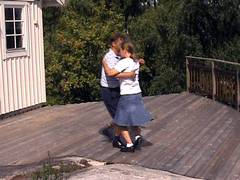 |
 |
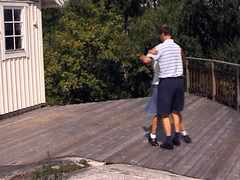 |
| Boda | 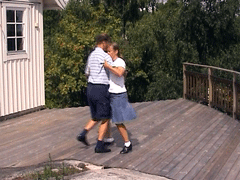 |
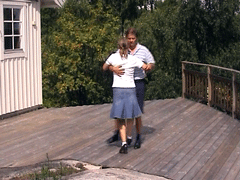 |
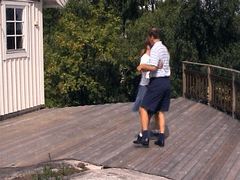 |
| Orsa | 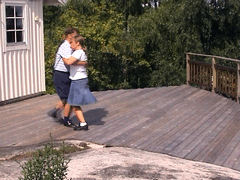 |
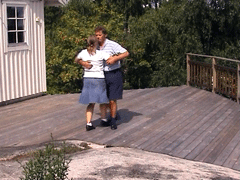 |
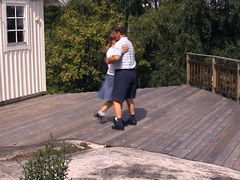 |
Polska from Rättvik - Rättvikspolska
When I first met this polska on a dance instruction, I thought it was an unfeasible dance. As I remember the instruction, both the leader and the follower takes a step on the first beat, on the second beat the leader takes a step with his right foot while the follower continues to turn, on the third beat the lady takes her step while the leader continues to turn.
Fairly soon we found a solution we liked. We have however unfortunately later compromised about that. Note that our solution not follows the written instructions for the polska, as I as a leader take my left foot of the ground already on the second beat.
The problem that made me frustrated in the beginning was that if I lift my left foot on the second beat, I had no force to lead the turn. This will very often result in a too short turn, making the couple to dance inwards towards the centre of the room.
There is an obvious solution, to let the left foot stay on the ground and lead the turn as in Bingsjöpolska. This was however not what I was aiming for.
The trick that took me over this frustration was to lift the left foot, holding the foot and the leg out a little to the left. This gives the couple a higher turning momentum leading to that the lady feels some resistance.
When the lady overwins this resistance it creates a turning momentum that the leader can reuse before the first beat by moving his left leg and foot inwards towards the centre, and in this way keep turning as long as needed to keep the line on the dance floor. It is important that the follower before that, on the third beat, overcomes the resistance and gives the couple the momentum needed.
This way to dance gives a little twitch within the couple that perfectly match the music. I have however encountered that instructors have other ideas about how the dance shall be danced, and this has resulted in that the method described above is somewhat disguised by moderating how much the left foot and leg is held out. This leads to that the polska comes closer to the instructed version, but leads unfortunately also to that the nice twitch is lost.
Bondpolska
The Bondpolska I met long ago, at some dances at Bollnästorget (Skansen).
The dance differs from most other polskor during the polska walking steps. The couple then keeps a closed hold, where the leader ´walks´ forwards, the follower backwards. Of course, as with most polskor, the walking steps are not plain walking, it is a dance with the first step lasting two beats, the second one, in harmony with the music.
During the turns, it might look like the follower jumps forwards, helped by the leader lifting her.
However I think that is an illusion. Rather, the leader takes a relatively long step backwards in the dancing direction, causing a substantial traction force to the follower. That leads to that the follower flies forwards and around the leader to a soft landing backwards.
Unfortunately I have no video recording of us dancing bondpolska.
Last updated: Mar 09, 2024